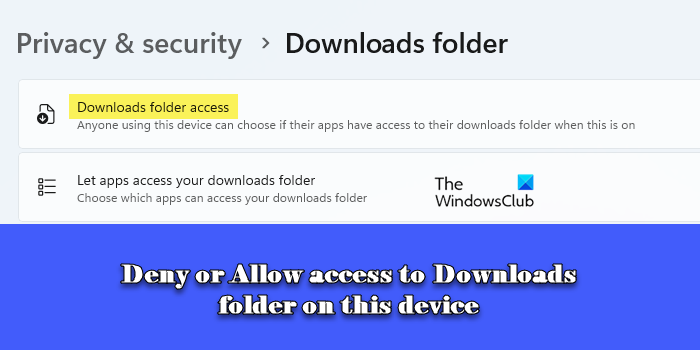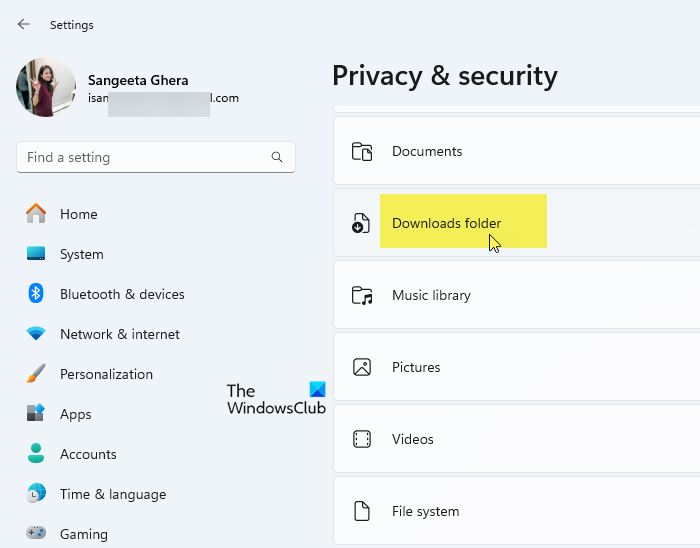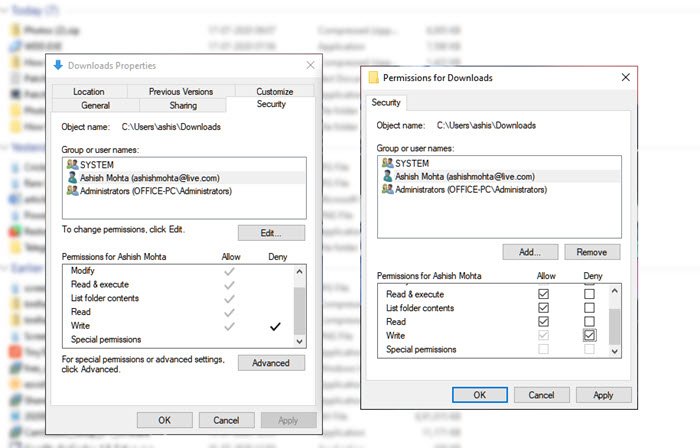Windows Privacy Settings offer File System settings, which makes sure that unless allowed, Apps will not be able to access the File System, and user folders such as Documents, Pictures, videos, and local OneDrive Files. Some apps need access to the File System to work as intended. In this post, we will show how you can deny or allow access to the Downloads folder.

Deny or Allow access to the Downloads folder on this device
All Windows users have access to their personal folders, but applications must request this access, and you can choose to allow or deny the request. When apps get the same permission as their users, they can manage files and folders inside them. If you give an app permission but change your mind later, you can turn off access to the File System.
Please note that File System access grants broader access to the file system, allowing apps or browsers to read, write, and modify files across various directories on your device, while Downloads folder access grants access to the Downloads folder, enabling apps or browsers to save and read files only within this designated folder
Allow or block File system access in Windows

To allow or block File system access in Windows 11/10, follow these steps:
- Open Windows Settings (Win + I)
- Navigate to Privacy & security > File system.
- Turn on the toggle next to the File system access option.
- Next, under Let apps access your file system, turn on app access.
You can choose the individual apps and services for which you want to allow or block file system access and change the settings to On or Off.
Allow or block Downaloads folder access in Windows

To allow or block Downloads folder access in Windows 11/10, follow these steps:
- Open Windows Settings (Win + I)
- Navigate to Privacy & security > Downloads folder.
- Turn on the toggle next to the Downloads folder access option.
- To choose which apps can access your downloads folder, turn on the toggle next to the Let apps access your downloads folder option.
Why some apps and software do not appear in the file system access privacy settings?
Any app installed from outside the Microsoft Store will not appear on the list. If you download a program from the Internet or install it from a USB or DVD, it will not be visible here. These apps are also not affected by the Allow apps access your file system setting.
Note: If you are trying to configure this on a device connected with your workaround, you may be unable to manage it. You’ll see a message telling you that “Some settings are managed by your organization” at the top of the File system settings page.
Why none of the apps can save files in the Downloads Folder?
If you are wondering if the same can be applied to other programs, then here is the problem. Applications run using the same permission of the User. So it will be impossible to control anything outside Microsoft Store to deny or allow access to a specific folder. However, if you are not able to save anything into the downloads folder, it can be because of the permission access to the folder. Here is how to check and fix it.

Right-click on the Downloads folder, and select Properties. Switch to the Security tab, and select the user account or system account. As you switch between the users, it will reveal the permission for that User. If the Write permission to the folder is set to deny, then you need to make it allow.
- Select the User, and then click on the Edit button
- In the Permissions window, select the User again, and then uncheck the box next to Write under the Deny Column.
- Click on the Apply button, and then click on the OK button.
Now, if you or any application writes into the folder, it should not have an issue with it.
I hope the post was able to clarify why you may have an issue with writing or saving files into the Downloads folder, and that you were able to allow or deny access to the Downloads folder on your device. If you have any queries or doubts, please feel free to leave it in the comments section below.
Read: How to prevent or allow App access to File System in Windows.
How do I change download folder permissions?
To change the permissions of the Downloads folder on a Windows 11/10 PC, open File Explorer, right-click on the Downloads folder in the left panel and select Properties. Switch to the Security tab and click Edit. Select the user or group whose permissions you want to modify. To allow access, check the appropriate Allow boxes; to deny access, check the Deny boxes. Click Apply followed by OK to save the changes.
How to allow permission to download files?
To allow permission to download files on a Windows 11/10 PC, ensure your browser settings or application being used permit downloads and no extensions are blocking them. Ensure the Downloads folder itself is accessible and appropriate permissions are allowed for the desired user or group. Also, verify that your antivirus or firewall isn’t blocking downloads. If necessary, adjust its settings.
Read Next: Fix Slow loading Downloads folder in Windows.
Leave a Reply